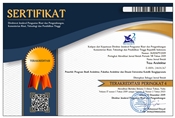Penilaian Livability Ruang Publik di Permukiman Padat Penduduk Studi Kasus Pada Ruang Publik di Permukiman RW 08 Kelurahan Lebak Siliwangi, Bandung
Abstract
Keywords
Full Text:
PDFReferences
Aswindi, W. (2006). Pemanfaatan Ruang Publik Majalaya. Bandung: Institut Teknologi Sepuluh Nopember.
Carr, S. (1993). Public Space. London: Cambridge University Press.
Churchman, A. (1999). Disentangling the concept of density. Journal of planning literature, 389–411.
Farida, A. (2014). Penerapan Konsep Child Friendly Space Pada Ruang Publik Kampung Badran Yogyakarta. Skripsi. Yogyakarta: Universitas Negeri Yogyakarta.
Habitat, U. (2013). Streets as Public Spaces and Drivers of Urban Prosperity. Nairobi: United Nations Human Settlements Programme (UN-Habitat).
Harrop, L. (2008). Tests for Liveability: Keeping pace with change. Social City 23.
Howley, P., Scott, M., & Redmond, D. (2009). Sustainability versus liveability: an investigation of neighbourhood satisfaction. Journal of Environmental Planning and Management, 847-864.
Kumar, R. (2005). Research Methodology: A Step by Step Guide For Beginner. London: SAGE.
Leby, J. L., & Hashim, A. H. (2010). Liveability Dimensions and Attributes: Their Relative Importance in the Eyes of Neighbourhood ResidentS. Journal of Construction in Developing Countries, 15(1), 67–91.
Lynch, K. (1981). Theory of Good City Form. MIT Press.
Marans, R. W., & Stimson, R. J. (2014). Investigating quality of urban life: theory, methods, and empirical research. Dordrecht: Springer.
Nasution, A., & Zahrah, W. (2012, July). Public Open Space’s Contribution to Quality of Life: Does Privatization Matter? Asian Journal of Environment-Behaviour Studies, 3.
Neuman, M. (2005). The compact city fallacy. Journal of planning education and research, 11-26.
Paasch, S. (2015). Livable dimensions of public spaces: A psychological analysis of health, well-being and social capital in urban squares. Dresden: Technische Universität Dresden Faculty of Science Department of Psychology.
PPS. (2005). (Project for Public Space) Retrieved March 12, 2016, from What makes a Successful Place?: http://www.pps.org/reference/grplacefeat/
Rahmi, D. H., Wibisono, B. H., & Setiawan, B. (2001). Rukun and Gotong Royong: Managing Public Places in an Indonesian Kampung. Public Places in Asia Pacific Cities, 119-134.
Sunaryo, R. G., Soewarno, N., Ikaputra, & Setiawan, B. (2010, November 20). Posisi Ruang Publik dalam Transformasi Konsepsi Urbanitas Kota Indonesia. Seminar Nasional Bidang Ilmu Arsitektur dan Perkotaan: Morfologi Transformasi dalam Ruang Perkotaan yang Berkelanjutan.
Susanti, R., Soetomo, S., Buchori, I., & Brotosunaryo, P. (2015). Smart growth, smart city and density: in search of the appropriate indicator for residential density in Indonesia. CITIES 2015 International Conference, Intelligent Planning Towards Smart Cities (pp. 194 – 201). Surabaya: Procedia - Social and Behavioral Sciences.
Victorian Competition and Efficiency Commision. (2008). State of Liveability: an inquiry into enhancing. Retrieved March 12, 2016, from http://vcoss.org.au/document/a-state-of-liveability-an-inquiry-into-enhancing-victoriaaes-liveability-draft-report/.
DOI: https://doi.org/10.24167/tesa.v17i2.1260
ISSN 1410-6094 (Print) | ISSN 2460-6367 (Media Online) | View My Stats

This work is licensed under a Creative Commons Attribution 4.0 International License.








